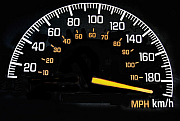Baccarat Play Rules & Punto Banco
by Gayle Mitchell
This lesson at Learn Poker will teach Baccarat play rules along with the related version--Punto Banco, both of which are exciting casino games played online and off. If you like blackjack, you will probably like this game, because the two are similar.
History shows that Baccarat was discovered first and, unlike blackjack, does not require extensive strategy. All you really have to do is pick a side: banker hand or player hand--an easy decision.
I realize that many casino visitors, whether online or off can feel intimidated by baccarat play.
The table is usually in a secluded pit area with rich decor and tuxedo-clad people everywhere.
For a long time I wouldn’t even get close enough to find out the rules or what was going on in those plush areas.
Now I know what I was missing by not participating in baccarat play...a lot!
Baccarat play is dealt from a shoe. Some tables can accommodate 16 players (with no #13). The shoe holds eight decks of cards.
In each game, the player and the banker are each dealt a hand of two cards.
You bet on either of the two hands to win. Winning means coming closest to a value of nine, and not over.
Directly in front of you are two boxes. The box closest to you is for betting that the player will win the next hand, and the box furthest from you is for betting that the banker will win. Most casinos have a minimum bet.
All number cards, 2 through 9, count as their face value or the number of pips on the card. All 10s and face cards count as 10. Aces count as 1. No hand can be worth more than 9.
If it is, the last digit of the total is used.
For example, if the hand has a king (10) and a 2, then it totals not 12, but 2.
To determine the value of a hand greater than 9, simply use the last digit of the total number--such as 9 for 19, 0 for 20 or 7 for 17.
It’s important to remember that no hand is too bad or too good to win, because the count can change with the third card, if one is required.
The casino encourages players to deal cards from the shoe, but you are not obligated to deal. The shoe passes around the table in a counterclockwise direction. The player holding the shoe is considered the banker.
However, the banker does not take any additional risk. Technically he/she is not the banker but represents the banker’s hand.
The dealer will determine which player has the largest bet on the player’s hand, and will give that person the two cards representing the player’s hand. Both hands are displayed and the totals for each hand are called out.
At this point, baccarat play may not be over, depending on whether or not a third card is required. The dealer instructs the banker when and if to draw a third card.
After the third card is dealt, if required, the dealer announces the winner--saying, for example, ‘Banker wins 5 over 3’.
Mathematically, the banker hand has a slight edge over the player hand, because of the third card rules. This would mean that you should always bet on the banker hand.
However, the casinos have come up with a solution to this: they charge players a 5% commission each time they bet on the banker to win. The dealers are responsible for keeping track of how much commission is owed in dollars.
In front of each dealer is a row of numbered boxes. Each time you have a commission payable; it is noted at your corresponding box number with token chips. When you are finished playing, make sure you have enough money in front of you to cover this debt.
Besides betting that the player or banker will win, you could bet that there will be a tie. With a casino advantage of 14%, the tie bet is the only bad bet.
A tie is always a push, so the banker or player bets stand when a tie is dealt.
Most casinos will provide a score sheet and pen if you ask. Use these to track trends, patterns and streaks in the making during baccarat play.
Unlike blackjack, you can sit out or skip hands; just tell the dealer “no bet”. Use this break to analyze your scorecard for your next strategy move.
Some gamblers keep these scorecards for a running history of their play.
You may have noticed that I have not gone into a lot of detail about the third-card rules for standing or drawing. That information can be found in the next baccarat play lesson.
Punto Banco:
A related version of baccarat with a few name changes.
For example: Shoe=sabot. Bank=Banco. Player=Punto. Dealer=croupier is in charge of the game, representing the punter.
The Tie bet pays eight times the stake and may not be more than a quarter of the maximum stake.
The first card brought out by the croupier and turned over determines the value of cards forthcoming before the first game of a new shoe begins.
If a face card, then 10 unturned cards are discarded. If a 7 shows, then 7 unturned cards are discarded, etc. All cards are dealt face up.
This procedure can make card counting a little more difficult.
Baccarat Play is followed by Strategies
OR
How to Play Poker 1 Program
OR
Learn Poker Games 2 with 7 Game Types
Gambling Teachers Home
GT is attentive about getting the word out about our free programs, lessons and add-ons offered, however, we ask your assistance and consideration in promoting us.
Click link below that reads, "Enjoy this page? Please pay it forward. Here's how..." to add a link to your site, blog or personal page.
Tips, Terms & Wins
Pusoy Poker, also know as Chinese Poker is based on the game of Pai Gow Poker and played mainly in Asia and the Phillipines.
The attraction is that unlike pai gow poker that has endless ties and no winner, pusoy offers a payout for each hand.





